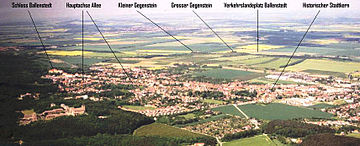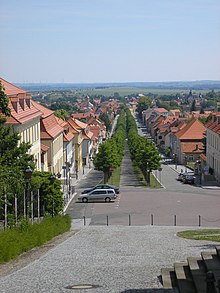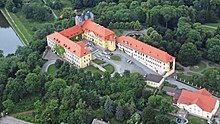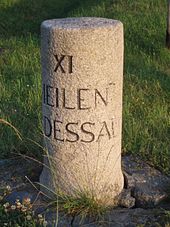Ballenstedt
| coat of arms | Germany map | |
|---|---|---|

|
Coordinates: 51 ° 43 ' N , 11 ° 14' E |
|
| Basic data | ||
| State : | Saxony-Anhalt | |
| County : | resin | |
| Height : | 236 m above sea level NHN | |
| Area : | 86.65 km 2 | |
| Residents: | 8846 (Dec. 31, 2019) | |
| Population density : | 102 inhabitants per km 2 | |
| Postal code : | 06493 | |
| Primaries : | 039483, 039485 | |
| License plate : | HZ, HBS, QLB, WR | |
| Community key : | 15 0 85 040 | |
| LOCODE : | DE BAT | |
| NUTS : | DEE09 | |
| City structure: | 6 districts | |
City administration address : |
Rathausplatz 12 06493 Ballenstedt |
|
| Website : | ||
| Mayor : | Michael Knoppik | |
| Location of the city of Ballenstedt in the Harz district | ||
Ballenstedt is a small town in the Harz district in Saxony-Anhalt (Germany). The Romanesque Road runs through the city .
geography
location
Ballenstedt is located on the northeastern edge of the Harz Mountains . Aschersleben is about 16 kilometers east, Quedlinburg about 10 kilometers northwest.
Neighboring communities are Seeland ( Salzlandkreis ), Falkenstein / Harz , Harzgerode and Quedlinburg .
Districts
The districts of Ballenstedt with the number of inhabitants in brackets:
|
|
Dialect border
Ballenstedt is located immediately south of the Benrath line and thus at the transition from the High German - more precisely: the East Central German - dialects to the Low German language .
history
The first reliable mention of Ballenstedt is in a document from King Heinrich IV. From 1073. Count Esico von Ballenstedt , who is never named after Ballenstedt in contemporary sources, was probably Uta's brother , one of the founders of Naumburg Cathedral . Esico is considered to be the progenitor of the Askanians . On today's Schlossberg he had the collegiate monastery of St. Pancratius and Abundus built, which was opened in 1046 in the presence of King Heinrich III. was consecrated. However, this document is probably forged. Esiko's son and successor was Adalbert II. His son Otto the Rich and his son Albrecht the Bear , who later became the first Margrave of Brandenburg , converted the monastery into a Benedictine monastery in 1123 . Otto the Rich is the first Ascanian to call himself after Ballenstedt, in 1106. Albrecht the Bear was buried in 1170 in the monastery church of Ballenstedt. His grandson Heinrich I was the first Prince of Anhalt. The place Ballenstedt is mentioned for the first time in 1297 as "Dorp" and in 1512 it received the brewing rights from Prince Wolfgang von Anhalt . During the Peasants' War the Benedictine monastery was stormed and partially destroyed and in 1525 it was secularized by Prince Wolfgang von Anhalt and expanded as a residence. In 1543 Ballenstedt was granted city rights. A city fortification was built in 1551, and a town hall and council are mentioned for the first time in 1582. During the Thirty Years War in 1626 Wallenstein's troops stormed the city and sacked it.
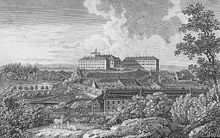
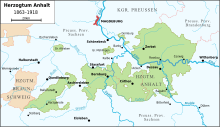
From the 17th century onwards, Ballenstedt was further expanded by the princes of Anhalt-Bernburg . A representative palace complex was built on the remains of the former monastery. In 1765 Prince Friedrich Albrecht officially declared Ballenstedt a royal seat, and the political, economic and cultural heyday began. The building of the palace theater , which was started in 1788, was an expression of the cultural rise . Albert Lortzing and Franz Liszt later appeared here , who helped the theater gain an important reputation across Anhalt's borders.
When Duke Alexander Carl died childless in 1863 , Anhalt-Bernburg fell to Dessau , and Ballenstedt became one of the five district towns of the reunified state of Anhalt - the Ballenstedt district existed until 1950. Ballenstedt gradually developed into the domicile of wealthy pensioners and with the tourist development of the Harz, the city experienced a new boom also through tourism. So spent z. B. Friederike von Schleswig-Holstein-Sonderburg-Glücksburg , widow of the last Duke of Anhalt-Bernburg , here her old age. The castle served as the hunting and secondary residence of the Dukes of Anhalt until 1918 and as the private residence of the ducal family until 1945.
During the time of National Socialism , the Jewish residents present in the village were expelled or deported for extermination. A memorial stone in the Jewish cemetery commemorates them. During the Second World War , more than 100 men and women, mainly Poles , had to do forced labor in the rubber works founded in 1936 and on the castle domain , which claimed numerous lives. Between 1936 and 1945, the Napola NPEA Anhalt was located on the Großer Ziegenberg , which served as the SED district party school in GDR times - today's training center Großer Ziegenberg . After the end of the Second World War, the character of Ballenstedt changed. The castle, which had previously been the summer residence of the ducal family, was expropriated and converted into a forestry engineering school in 1949 . The tourist structures were not promoted any further and almost came to a standstill, but industrial operations gained in importance. It was not until the end of the GDR that more attention was paid to tourism, which was reflected in the renovation of the castle and its opening to visitors as well as the reconstruction of the Great Inn. After 1990 many businesses went into decline. This is reflected in the population decline from approx. 12,000 to less than 8,000.
Ballenstedt has been a state-approved resort since 2010 .
- Incorporations
On July 1, 1950 Opperode was incorporated. Badeborn was incorporated on August 4, 2002. Radisleben joined on January 1, 2010. The municipality of Rieder was incorporated on December 1, 2013.
politics
City council
The local elections on May 26, 2019 resulted in the following distribution of seats in the city council , with a turnout of 53.2% (2014: 43.2%):
- CDU : 4 seats
- AfD : 3 seats
- Left : 2 seats
- Citizens' Alliance Rieder: 3 seats
- Badeborn community of interests: 2 seats
- FDP : 2 seats
- SPD : 2 seats
- Greens : 2 seats
The first city council elected in the Weimar Republic had the following face:
- SPD: 9 seats, civic association: 6, medium-sized association 3.
The first local election after the fall of the Wall in the GDR on May 6, 1990 brought the following result for the Ballenstedt city council:
- CDU: 10 seats, SPD: 2, FDP: 2 PDS: 2, Ballenstedter Neues Forum: 2, farmers' party: 1, individual candidate: 1.
Mayor of the city of Ballenstedt
|
|
coat of arms
Blazon : “Split, in front under a golden shield head divided five times black over gold, behind over a golden shield base five times divided gold over black. On the temple helmet with neck jewelery and golden-silver blankets a golden pole with three black bars. "
However, the correct blazon of the coat of arms is: "Split in gold, three black bars broken down to the right." This is also the case with a blazon usually only refers to the coat of arms and not to the accessories. In the case of the Ballenstedt coat of arms, the described accessories are interesting in that the three bars on the helmet - here in unbroken form - appear as a representation of the coat of arms.
The "Great Coat of Arms" has an upper coat of arms . Here are three continuous black bars on a continuous golden pole in the crest above the heraldic helmet with the golden helmet covers. Otto the Rich led the continuous beams in the so-called beam shield at the end of the 12th century.
Meaning: The coat of arms is a variety of the coat of arms of the Counts of Ballenstedt. After the town elevation of Ballenstedt it is stated in 1560. The coat of arms of the Counts of Ballenstedt, from which the city arms of Ballenstedt was derived, was divided nine times by black and gold.
flag
The flag of the city of Ballenstedt is longitudinally black and yellow striped lengthways (1: 1) and in the middle of the yellow stripe with the full coat of arms of the city of Ballenstedt.
Town twinning
Ballenstedt has had a partnership with the Hessian city of Kronberg im Taunus since October 6, 1988 .
Attractions
- Ballenstedt Castle : Baroque three-winged building, renovated at the beginning of the 18th century, grave of Albrecht the Bear . The palace complex includes structural remains of the Romanesque former monastery church of St. Pancratius and Abundus, including their west bar .
- Palace park: designed by Peter Joseph Lenné ; The palace and palace park are part of the Garden Dreams Saxony-Anhalt project
- Schlosstheater Ballenstedt : used a. a. by Albert Lortzing and Franz Liszt
- Schlosshotel Großer Gasthof: originally built as an armory in 1733 , converted into an inn in 1756 by the Braunschweig-Wolfenbüttel ducal master builder Martin Peltier de Belfort
- City museum "Wilhelm von Kügelgen" , opposite the large inn in the upper part of the avenue
- Kügelgen House, Kügelgenstr. 35a
- Yellow house, at the city exit towards Rieder , built as a Zollweghaus
- Allee: representative, one kilometer long driveway to the castle, center of the city
- Old Town Hall: half-timbered building built in 1683
- New Town Hall: representative building, in 1906, designed by the Berlin architect Alfred Messel built
- St. Nicolai Church: late Gothic sacred building in the old town, built in 1326, burned down in 1498, rebuilt in 1501
- City wall, a large part of which can still be seen in Wallstrasse
- Watchtowers of the city wall (upper tower, lower tower, market tower - the latter is accessible, key in the restaurant opposite)
- Bath house, built in 1907/08
- St. Elisabeth Church: built 1931–1933 in the Bauhaus style
- Devil's Wall (Harz)
- Gegensteine nature reserve
- Bismarck Tower , Opperode district
- Roseburg (castle)
- Oberhof Ballenstedt
- Napola Ballenstedt , former National Political Education Institute and later SED party school
→ see also: List of cultural monuments in Ballenstedt
exhibition
The association "Forum Großer Ziegenberg - Ballenstedt am Harz eV" has succeeded in showing an exhibition in Ballenstedt since mid-2015 on the eventful history of the building complex, which is now called the Großer Ziegenberg training center : it can be used as the "Staatliche Nationalpolitische Bildungsanstalt Ballenstedt" and as " district party school > Wilhelm Liebknecht <the district headquarters of the SED Halle, Ballenstedt". The special exhibition in the city museum "Wilhelm von Kügelgen" Ballenstedt comprises two rooms on the upper floor of the museum and is entitled "A school. Two stories. From NAPOBI to the SED party school. Großer Ziegenberg Ballenstedt. "

Art history
Caspar David Friedrich made Ballenstedt the motif of one of his main works. The painting Garden Terrace from 1811 shows the painter Caroline Bardua, who lives in Ballenstedt, on a bench in the tree-lined avenue between the castle and Neustadt. With his own construction principle, the romantic painter brought the Brocken , the Harz foreland, the surrounding wall of the old castle park and the avenue, in contrast to nature, into a visual axis. The Prussian King Friedrich Wilhelm III. bought the painting for the Berlin Royal Palace at the Academy Exhibition in Berlin in 1812. Today the picture is in the Charlottenhof Palace in Potsdam .
Memorials
- Grave site in the "Judengottesacker" cemetery in the Badeborn district for four Polish people (one child, one woman and two men) who were killed during the death march from the Langenstein-Zwieberge concentration camp , a subcamp of the Buchenwald concentration camp , in April 1945
- Memorial stone on the Jewish cemetery on Hoymer Strasse in memory of the Jewish victims of the Shoah
- Memorial stone in the cemetery with name plaque for five murdered anti-fascists in the region: Louis Riekehr, Georg Freitag, Ernst Pose, Otto Kiep and August Wolf
- Soviet cemetery of honor from 1945 for 65 deceased Red Army soldiers , moved to the municipal cemetery in 1995 , where 21 victims of forced labor are also remembered
- Memorial on the Brauberg , formerly for soldiers of the First World War , since 1990 dedicated to the victims of all wars and tyranny
- Grave site in the cemetery of the Opperode district for unknown prisoners from the subcamp of the Langenstein-Zwieberge concentration camp , who were murdered on the death march in April 1945
traffic
Road traffic
The federal highway 185 runs through Ballenstedt . A connection to the A 36 is 10 km away and the A 14 is 40 km away.
Rail transport
Ballenstedt is on the former Frose – Quedlinburg railway line . Rail traffic was opened on the section from Frose to Ballenstedt Castle (today Ballenstedt West) on January 7, 1868, the line was extended on July 1, 1886 via Gernrode to Quedlinburg . Rail traffic was stopped on December 13, 2003, the rails have been dismantled since 2015. The former railway line towards Gernrode was expanded into a cycle path in 2019 for 800,000 euros. An extension is planned from the western entrance to the village to the former Ostbahnhof.
Bus transport
The public transport system is, among other things by the PLUSBUS of the country's network of Saxony-Anhalt provided. The following connection leads through Ballenstedt:
- Line 240: Quedlinburg ↔ Gernrode ↔ Ballenstedt ↔ Meisdorf ↔ Aschersleben
In addition, Ballenstedt is a traffic hub in the bus network of the Harz transport company .
Air traffic
The Ballenstedt airfield , which has an 800 m long asphalt runway and is approved for night flight operations, is 5 km away .
economy
Larger companies and institutions:
|
|
religion
Ballenstedt is the seat of a parish of the same name of the Evangelical Church of Anhalt . The parish of St. Nikolai is located in Ballenstedt at Mühlstraße 14. This includes the parish of St. Nikolai (Ballenstedt with the Nikolakirche and Opperode with the St. Petri Church) and the castle parish (with the castle chapel from 1887 in Bebelstraße ).
The Catholic St. Elisabeth Church, built between 1931 and 1933 and consecrated to St. Elisabeth of Thuringia , is located at Quedlinburger Straße 4. The parish of St. Elisabeth, which is part of the Halberstadt deanery, includes the parishes in Gernrode (use of the Protestant collegiate church of St. . Cyriakus ) and in Harzgerode (St. Johannes Baptist ). A new parish hall was built next to the church in 2011 after the previous building from the 1950s was demolished in 2010. Another Catholic institution in Ballenstedt is from Malteser -borne rescue station .
The New Apostolic congregation Ballenstedt belongs to the church district Halberstadt and has a church on Mühlstrasse.
Events
The Rockharz Open Air has been taking place at the Ballenstedt-Harz airfield since 2009 .
Personalities
sons and daughters of the town
- Uta von Ballenstedt (around 1000 - before 1046), founder of the Naumburg Cathedral
- Johann Arndt (1555–1621), theologian
- Wilhelm Ernst Starke (1692–1764), Reformed theologian, philologist and hymn writer
- Ernst Julius Marx (1728–1799), organ builder
- Pauline zur Lippe (1769–1820), regent of the Principality of Lippe
- Caroline Bardua (1781–1864), painter
- Franz Junot (1785–1846), mining captain and son-in-law of Schiller
- Wilhelmine Bardua (1798–1865), writer, poet, singer, singing teacher, dramaturge and salonnière
- Luise von Anhalt-Bernburg (1799–1882), Princess of Prussia
- Christian Friedrich Gille (1805–1899), painter, draftsman and engraver
- Adolf Zeising (1810–1876), author and scholar
- August Reinhard (1831–1912), composer, author of a harmonium school
- Maximilian Curtze (1837–1903), high school teacher, mathematics historian, translator and editor
- Gustav Strube (1867–1953), composer
- Wilhelm von Krosigk (1871–1953), sea captain of the Imperial Navy , commander of the large-scale ship SMS Posen , rear admiral
- Wilhelm Thiele (1897–1990), politician (NSDAP)
- Marie Auguste von Anhalt (1898–1983), princess
- Hans Butzmann (1903–1982), librarian, Germanist and manuscript scholar
- Friedrich Bloch (1904–1996), Lord Mayor of Gera from 1945 to 1948
- Eduard Prinz von Anhalt (* 1941), head of the House of Anhalt-Askanien since 1963
- Justus Pfaue (1942–2014), writer and screenwriter
- Heidelore Böcker (1943–2019), mediaevalist and Hanseatic historian
- Eckhard Lesse (* 1948), long-distance runner
- Volker Schimpff (* 1954), politician (CDU)
- Martin Hoff (1965–2016), Kapellmeister
- Josepha Bock (* 2000), volleyball player
People connected to Ballenstedt
- Albrecht the Bear (1100–1170), Count von Ballenstedt, since 1157 Margrave of Brandenburg, buried in Ballenstedt
- Bernhard III. (1140–1212), Duke of Saxony, buried in Ballenstedt
- Johann Zechendorf , (1580–1662 in Zwickau) German philologist and educator
- Johann Caspar Häfeli (1754–1811), preacher, died in Ballenstedt
- Johann Gottfried Keßler (1754–1830) founded the Anhalt bernburg provincial collection of some fossils from 1783 at Bernburg Castle
- Karl Christian Kehrer (1755–1833), portrait, landscape and history painter; from 1778 princely Anhalt court painter; died in Ballenstedt.
- Carl Christian Agthe (1762–1797), composer and court conductor, worked and died in Ballenstedt
- Gotthelf Wilhelm Christoph Starke (1762–1830), Protestant theologian and educator
- Just Friedrich von Seelhorst (1770–1857), court marshal in Ballenstedt
- August von Krohn (* 1781; † 1856 in Ballenstedt) major general and minister of war
- Eduard Nehse (1794 – after 1855), natural scientist and innkeeper. 1852 initiator of the Ballenstedt Music Festival with Franz Liszt.
- Wilhelm von Kügelgen (1802–1867), painter and man of letters, worked and died in Ballenstedt
- Werner VIII von Alvensleben (1802–1877), Prussian lieutenant general, buried in Ballenstedt
- Gustav von Alvensleben (1803–1881), Prussian. General of the infantry, buried in Ballenstedt
- Constantin von Alvensleben (1809-1892), Prussian. General of the infantry, buried in Ballenstedt
- Friedrich Winfried Schubart (1847–1918), court preacher in Ballenstedt, bell expert and local researcher
- Friedrich von Scholtz (1851–1927), general in World War I, died and buried in Ballenstedt
- Hans Bartsch von Sigsfeld (1861–1902), inventor and aeronautical operator, buried in Ballenstedt
- Emil Baumecker (1866–1947), pastor and member of the state parliament of the Free State of Anhalt, spent many years of his childhood and youth as well as his old age in Ballenstedt
- Wilhelm Vöge (1868–1952), art historian, lived in Ballenstedt since 1917
- Fritz Klocke (1898–1978), teacher, folklorist and local researcher in Ballenstedt
- Marco Gebhardt (* 1972), soccer player, grew up in Ballenstedt
literature
- Bernhard Heese / Hans Peper (ed.): Ballenstedter Chronik. A history of the castle and the city in individual representations. From the beginning until 1920. Newly published by the Kulturverein Wilhelm von Kügelgen , Ballenstedt 2004, ISBN 3-937648-05-4 .
- Kulturverein Wilhelm von Kügelgen (Hrsg.): Ballenstedt in the 20th century 1920 to 2000. Continuation of the Ballenstedter Chronik. Convent, Quedlinburg 2003, ISBN 3-937648-00-3 .
- Berent Schwineköper (Hrsg.): Handbook of the historical sites of Germany . Volume 11: Province of Saxony Anhalt (= Kröner's pocket edition . Volume 314). 2nd, revised and expanded edition. Kröner, Stuttgart 1987, ISBN 3-520-31402-9 .
- Kurt Müller : History of the Ballenstedt district . Kulturverein Wilhelm von Kügelgen Ballenstedt eV (Ed.). Supplemented and edited by Karl-Heinz Börner and Christoph Schröter. Quedlinburg 2006, ISBN 3-937648-09-7 , DNB 982333978 .
- City administration Ballenstedt (ed.): Ballenstedt. Anhalt's cradle. Stadt-Bild-Verlag Leipzig 2014, ISBN 3-942146-63-0 .
- Stefanie Leibetseder: Ballenstedt . In: Gerhard Fouquet, Olaf Mörke, Matthias Müller and Werner Paravicini (eds.): Residenzstädte im Alten Reich (1300–1800). A manual . Department I: Analytical directory of the residential cities and manorial central locations. Part 1: Lower Saxony and Upper Saxony Imperial Circle, Schleswig, Prussia, Livonia, ed. by Harm von Seggern. Ostfildern 2018, p. 23-25 .
Web links
- Website of the city of Ballenstedt
- Information page about Ballenstedt of the Ballenstedt Tourist Association
Individual evidence
- ↑ State Statistical Office Saxony-Anhalt, population of the municipalities - as of December 31, 2019 (PDF) (update) ( help ).
- ↑ Axel Voigt (Ed.): History of Anhalt in data . Mitteldeutscher Verlag, Halle (Saale) 2014, ISBN 978-3-95462-229-0 , p. 496.
- ↑ Sights in Ballenstedt , accessed on April 26, 2017.
- ↑ Municipalities 1994 and their changes since January 1, 1948 in the new federal states , Metzler-Poeschel publishing house, Stuttgart, 1995, ISBN 3-8246-0321-7 , publisher: Federal Statistical Office
- ↑ State Statistical Office of Saxony-Anhalt ( Memento of the original from September 28, 2011 in the Internet Archive ) Info: The archive link was inserted automatically and has not yet been checked. Please check the original and archive link according to the instructions and then remove this notice. on the territorial changes 1994–2007
- ↑ Changes to the municipal area since July 1, 2007. State Statistical Office Saxony-Anhalt, accessed on August 17, 2012 .
- ↑ Results of the city council election 2019 In: ballenstedt.de , accessed on August 21, 2019 (PDF)
- ↑ Results of the city council election 2014 In: ballenstedt.de , accessed on August 21, 2019 (PDF)
- ↑ a b Main Statute of the City of Ballenstedt. (PDF) Retrieved August 17, 2012 .
- ↑ a b Heinz Göschel (Ed.): Lexicon cities and coats of arms of the German Democratic Republic. Leipzig 1979, p. 30.
- ↑ Detlef Stapf: Caspar David Friedrichs hidden landscapes. The Neubrandenburg contexts . Greifswald 2014, network-based P-Book
- ↑ Rita Kunze: Cycle path Cycle path between Ballenstedt and Gernrode: cycling without tracks. In: mz-web.de. July 3, 2019, accessed August 21, 2019 .
- ↑ Ambulance service in the Harz district surcharge for the Maltese. Mitteldeutsche Zeitung, August 17, 2018, accessed on October 11, 2019.
- ↑ Stefanie Leibetseder: Wilhelm Vöge in Ballenstedt . In: Helten / Hans W. Hubert / Olaf Peters / Guido Siebert (eds.): Continents of Art History - On the 150th birthday of Wilhelm Vöge . Mitteldeutscher Verlag, Halle 2019, p. 201-225 .



